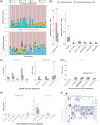Intertwined Dysregulation of Ribosomal Proteins and Immune Response Delineates SARS-CoV-2 Vaccination Breakthroughs
- PMID: 37022180
- PMCID: PMC10269832
- DOI: 10.1128/spectrum.04292-22
Intertwined Dysregulation of Ribosomal Proteins and Immune Response Delineates SARS-CoV-2 Vaccination Breakthroughs
Abstract
Globally, COVID-19 vaccines have emerged as a boon, especially during the severe pandemic phases to control the spread of severe acute respiratory syndrome coronavirus 2 (SARS-CoV-2) infections, saving millions of lives. However, mixed responses to vaccination with breakthrough challenges provided a rationale to explore the immune responses generated postvaccination, which plausibly alter the subsequent course of infection. In this regard, we comprehensively profiled the nasopharyngeal transcriptomic signature of double-dose-vaccinated individuals with breakthrough infections in comparison to unvaccinated infected persons. The vaccinated individuals demonstrated a gross downregulation of ribosomal proteins along with immune response genes and transcription/translational machinery that methodically modulated the entire innate immune landscape toward immune tolerance, a feature of innate immune memory. This coordinated response was orchestrated through 17 transcription factors captured as differentially expressed in the vaccination breakthroughs, including epigenetic modulators of CHD1 and LMNB1 and several immune response effectors, with ELF1 emerging as one of the important transcriptional regulators of the antiviral innate immune response. Deconvolution algorithm using bulk gene expression data revealed decreased T-cell populations with higher expression of memory B cells in the vaccination breakthroughs. Thus, vaccination might synergize the innate immune response with humoral and T-cell correlates of protection to more rapidly clear SARS-CoV-2 infections and reduce symptoms within a shorter span of time. An important feature invariably noted after secondary vaccination is downregulation of ribosomal proteins, which might plausibly be an important factor arising from epigenetic reprogramming leading to innate immune tolerance. IMPORTANCE The development of multiple vaccines against SARS-CoV-2 infection is an unprecedented milestone achieved globally. Immunization of the mass population is a rigorous process for getting the pandemic under control, yet continuous challenges are being faced, one of them being breakthrough infections. This is the first study wherein the vaccination breakthrough cases of COVD-19 relative to unvaccinated infected individuals have been explored. In the context of vaccination, how do innate and adaptive immune responses correspond to SARS-CoV-2 infection? How do these responses culminate in a milder observable phenotype with shorter hospital stay in vaccination breakthrough cases compared with the unvaccinated? We identified a subdued transcriptional landscape in vaccination breakthroughs with decreased expression of a large set of immune and ribosomal proteins genes. We propose a module of innate immune memory, i.e., immune tolerance, which plausibly helps to explain the observed mild phenotype and fast recovery in vaccination breakthroughs.
Keywords: COVID-19; immune tolerance; milder disease severity; ribosomal proteins; transcription factors; vaccination breakthroughs.
Conflict of interest statement
The authors declare no conflict of interest.
Figures








References
-
- Yang SL, Mat Ripen A, Leong CT, Lee JV, Yen CH, Chand AK, Koh K, Abdul Rahim NAB, Gokilavanan V, Mohamed NNEB, Sevalingam RKA, Sulaiman N, Ab Razak AKB, Mohd Nor NHB, Pong MK, Tai KY, Toh V, Woon YL, Peariasamy KM. 2022. COVID-19 breakthrough infections and humoral immune response among BNT162b2 vaccinated healthcare workers in Malaysia. Emerg Microbes Infect 11:1262–1271. doi: 10.1080/22221751.2022.2065936. - DOI - PMC - PubMed
Publication types
MeSH terms
Substances
LinkOut - more resources
Full Text Sources
Medical
Research Materials
Miscellaneous

